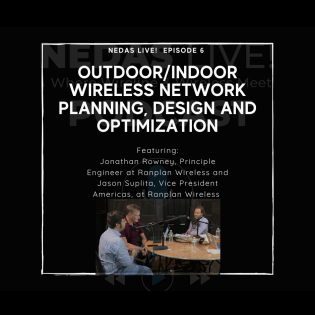
In a technology-driven world of competition and fast-paced evolution, market differentiation and outstanding service delivery remain vital pillars of success throughout the IT and telecommunications spheres. As 5G and other technologies come closer to full-scale rollout, the converging world of wireless and wireline has become host to a vast array of new strategies and build methods to meet the needs of tenants and network users. As a result, the means of business differentiation throughout the industry are changing.
To explore this connected and converging world of wireline and wireless, the NEDAS Live! Podcast, hosted by Ilissa Miller, President of NEDAS and CEO of iMiller Public Relations, and Steve Yapsuga, Co-Chair of the NEDAS Advisory Council and North American Director of Sales for Comba Telecom, welcomed two individuals from Ranplan Wireless. Jason Suplita, Executive of the Americas Region, and Jonathan Rowney, Principle Engineer for the company, began by explaining the importance of thinking outside the box as heterogeneous solutions become critical. They note that in the new world of differentiation, a true connectivity system doesn’t just include Distributed Antenna Systems (DAS) or small cells, and it isn’t limited to the location of the equipment. As Rowney states, “We really should be focused on providing the best level of service that we can.” Nowadays, this promise of heightened levels of service relies on bringing the outdoor and the indoor together as a collective.
Throughout the U.S., every provider or service integrator has a different set of best practices for public safety and commercial deployments. Rowney notes that this is due to the fact that best practices are differentiated and driven by their audiences — or whoever the company is trying to sell designs to. This could be carriers, jurisdictions or building owners. Each has unique demands for the space at hand. He adds that in the spaces that aren’t driven by carrier influences, there is more room for equipment manufacturers and integrators to take leadership. Overall, however, real-world data or predictive tools that can give a clearer idea of the desired project are critical for upholding best practices. Suplita comments that the key is making it easier to visualize the deployment and its capabilities and ensuring that that information can be related to the audience or customer in an approachable way.
Furthermore, in an industry that has a large focus on cost justification and efficiency, many providers may be sacrificing quality in favor of delivering low costs and quick deployments. Creating integrity while delivering solutions that meet all needs involves aligning visions while maintaining realistic expectations. So, when collaborating on the design, a platform has to be able to take the information and measurements and share it with the many stakeholders to allow inputs and concerns to be aired. At the end of the day, successfully addressing the pain points of the customer or building owner comes down to ensuring quality through the proper communication of the design.
So, as some would say, differentiation of service delivery and deployment success has a lot to do with managing the ecosystem surrounding the builds. Certification programs play a large part in ensuring understanding of new technologies, and original equipment manufacturers (OEMs) can act as guides for new integrators. Designers’ backgrounds can also be widened to ensure they have accurate and up-to-date knowledge to make decisions about go-forward plans. Regardless of the needs of the customer, it’s clear that as new strategies surrounding RF and CBRS emerge, ensuring understanding and clarity of service and design across the board will be key to building wireless systems that check all the boxes.
To learn more about NEDAS, please visit www.nedas.com.
To learn more about the NEDAS Live! Podcast or submit yourself for consideration to appear on an episode, please click here.





